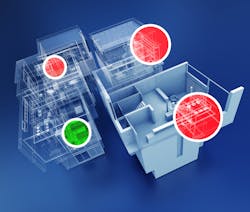Modular Test Gear Can Tame Wireless IoT Environments
The growth in sales of Internet-of-Things (IoT) products is expected to be record breaking for the next few years, as homes, offices, stadiums, and even cars—in short, any place where people gather—can benefit from having “things” communicating their data to “the cloud” by way of the Internet. For most of these IoT devices, that means of communications will be via either licensed or unlicensed wireless access.
The general idea of having IoT sensors in place is to turn lights on and off to save energy, lock doors for security, and perform whatever other functions these Internet-connected things are capable of to make life easier for people. Of course, for the RF/microwave engineers involved with these applications, a locale heavily populated with IoT devices will resemble the equivalent of an electromagnetic (EM) “stew,” with potentially thousands of wireless devices dumping data to the Internet over their respective frequencies.
Various studies have predicted that there will soon be more things on the Internet than people. These IoT devices will include sensors for thermal, motion, light, and humidity detection, along with many other sensing functions that will use technology to improve the quality of life for many people. However, testing such devices will not be trivial—taking their mixes of RF and digital hardware and software into account—especially given the highly competitive markets for such products and the importance of performing measurements in timely, cost-effective manners.
A number of leading instrument makers, including Tektronix, National Instruments, and Keysight Technologies, have already addressed some of the challenges connected with characterizing IoT devices. Because of the massive scale of production for some IoT products, the test approaches are being compared to those used for cellular telephones, where shaving pennies from the cost of testing each product can be significant.
Of course, testing IoT devices in production is considerably different from performing measurements on the same devices within their operating environments, where every IoT device is a potential source of interference to every other IoT device. Portable spectrum analyzers that are battery powered and light in weight, coupled with directional antennas, will be invaluable tools for maintaining the EM integrity of operating environments filled with IoT devices. This will ensure their connectivity and their interoperability with other wireless devices, such as cell phones.
Testing so many wireless IoT devices in their operating environments, with so many known and unknown signals, is much like testing a military signal-intelligence (SIGINT) system. Test instruments capable of testing those systems will have many of the characteristics needed to sort through the potentially thousands of low-level wireless signals from environments loaded with IoT devices.
As an example, the recently introduced model M9703B AXIe digitizer/receiver from Keysight Technologies was nominally intended for performing signal analysis in radar and electronic-warfare (EW) applications, but it also offers capabilities for capturing and processing the many signals in a crowded wireless IoT environment—at least to 2 GHz in this current version of the instrument.
The digitizer/receiver samples signals across eight channels at rates to 3.2 GSamples/s and 12-b resolution as a result of its high-performance analog-to-digital converters (ADCs). And it operates across a wide instantaneous bandwidth for real-time capture of multiple signals.
While such an instrument may not be the ultimate solution for signal acquisition in dense wireless IoT environments, it represents an effective architecture for a practical solution. Higher frequency coverage will be needed for inclusion of Bluetooth and wireless-local-area-network (WLAN) frequency bands, and possibly wider instantaneous bandwidths.
But the beauty of a modular instrument format such as AXIe (or PXI/PXIe) is that capability can be upgraded by adding modules as needed. And as the number of IoT signal sources in an operating environment grows, the number of modules in an AXIe or PXIe test solution can increase to keep pace with the measurement requirements.
Looking for parts? Check out SourceESB.
About the Author
Jack Browne Blog
Jack Browne, Technical Contributor, has worked in technical publishing for over 30 years. He managed the content and production of three technical journals while at the American Institute of Physics, including Medical Physics and the Journal of Vacuum Science & Technology. He has been a Publisher and Editor for Penton Media, started the firm’s Wireless Symposium & Exhibition trade show in 1993, and currently serves as Technical Contributor for that company's Microwaves & RF magazine. Browne, who holds a BS in Mathematics from City College of New York and BA degrees in English and Philosophy from Fordham University, is a member of the IEEE.

